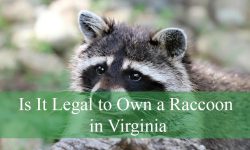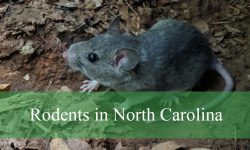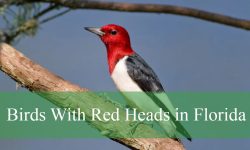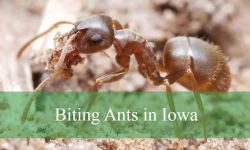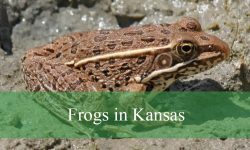Wyoming is known for its vast landscapes and rich wildlife, making it a perfect home for many fascinating bird species. Among them, owls hold a special place due to their mysterious nature and incredible adaptations. In this article, we will explore 14 different owls in Wyoming, complete with pictures and identification tips to help you recognize each species.
For avid birdwatchers and anyone curious about the nocturnal creatures of Wyoming, this guide provides valuable insights. Each owl species has unique features, from size and color to behavior, playing an important role in the local ecosystem.
Join us as we dive into the world of owls in Wyoming and discover how to spot these amazing birds in forests, grasslands, and wildlife refuges across the state. The clear photos included will make it easier for you to identify these incredible night hunters on your next outdoor adventure.
Common Owls Found in Wyoming
Great Horned Owl (Bubo virginianus)
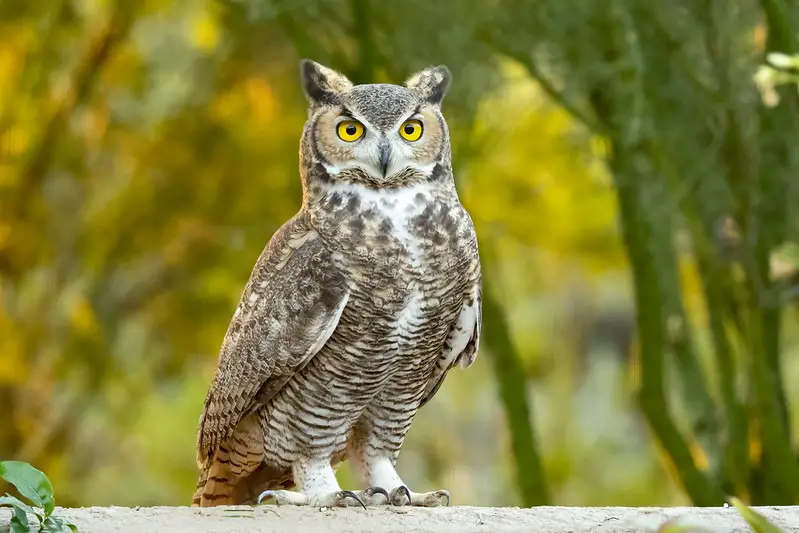
The Great Horned Owl is one of the most iconic and widespread owls in North America, and it is a common year-round breeder across Wyoming. This large owl is easily recognized by its prominent ear tufts (which are actually feather tufts, not ears), striking yellow eyes, and deep hooting call that echoes through forests and fields at night. Adults measure around 18 to 25 inches in length, with a wingspan of 3.3 to 4.8 feet, and weigh between 2 to 5.5 pounds. Their plumage is mottled gray-brown, providing excellent camouflage against tree bark.
Primarily nocturnal, Great Horned Owls are apex predators in their environments, hunting from perches with incredible stealth and accuracy. Their diet is highly varied, including mammals such as rabbits, squirrels, and skunks, as well as birds, amphibians, and even other raptors. They have incredibly strong talons and a powerful grip that allows them to take down prey larger than themselves. Their call is a classic “hoo-hoo-hoo-hoo” pattern that becomes especially prominent during the breeding season in late winter.
In Wyoming, they inhabit a wide range of environments, including forests, river valleys, open fields, and even urban areas. Their adaptability to different habitats makes them one of the most successful owl species in the region. You’re likely to find them nesting in old hawk or crow nests, tree cavities, cliff ledges, or even buildings. Because they are territorial and year-round residents, their deep hoots can often be heard on cold winter nights throughout the state.
Snowy Owl (Bubo scandiacus)

The Snowy Owl is a stunning and rare winter visitor to Wyoming, usually seen in open prairies, grasslands, and agricultural fields. Its bright white plumage, sometimes marked with dark bars or spots (especially in females and juveniles), provides excellent camouflage in snowy landscapes. These large owls can reach lengths of 20 to 28 inches, with wingspans up to 5.5 feet, and typically weigh between 3.5 to 6.5 pounds. Their piercing yellow eyes and bulky bodies make them unmistakable in the open country.
Unlike most owls, Snowy Owls are often diurnal, meaning they hunt during the day as well as at night. They have a reputation for being powerful and aggressive hunters, feeding mostly on lemmings and voles in their Arctic breeding grounds. In winter, when they move south, they shift to hunting rabbits, waterfowl, and rodents. Snowy Owls fly low and silently over the ground, using sharp vision and acute hearing to detect prey even under snow.
In Wyoming, their presence is considered irruptive, meaning they appear irregularly based on prey availability in the Arctic. During some winters, especially when food is scarce in the north, more Snowy Owls migrate southward and can be seen across the eastern plains and basins of the state. They prefer treeless expanses and are often spotted perched on fence posts, hay bales, or even airport runways. Birders usually watch for them between November and March, when occasional influxes occur.
Barred Owl (Strix varia)
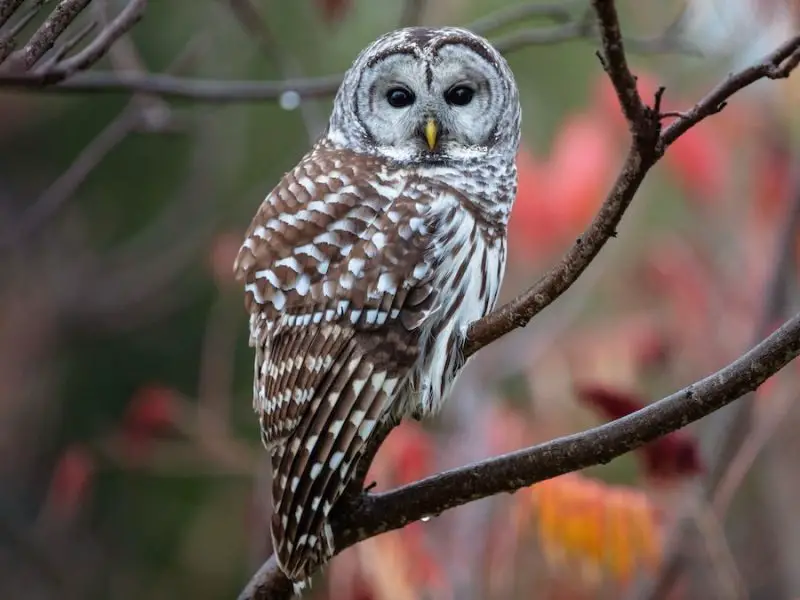
The Barred Owl is a large, stocky owl with a rounded head and no ear tufts, giving it a smooth, soft appearance. It is easily identified by its dark brown eyes—a unique trait among most North American owls that typically have yellow eyes. Its plumage is brown and white, with vertical barring on the chest and horizontal bars on the belly. Adults grow to about 16 to 25 inches long, with a wingspan of around 3.5 to 4.5 feet, and weigh between 1.5 to 3 pounds. Its call, famously described as “Who cooks for you? Who cooks for you all?”, is a loud and rhythmic hooting.
This owl prefers mature forests with nearby water sources, such as swamps, riparian woodlands, or dense coniferous stands. It hunts mainly at night, feeding on a diet of small mammals, amphibians, birds, and reptiles. Barred Owls use a combination of perching and gliding silently through the forest canopy to surprise prey. Their large eyes give them excellent night vision, and their feather structure allows for nearly soundless flight.
In Wyoming, the Barred Owl is considered a rare vagrant, though there have been documented nesting records in Grand Teton National Park. Their expansion westward is relatively recent and has sparked interest among ornithologists, as they were historically absent from much of the western U.S. If they continue to establish a foothold in northwestern Wyoming, they may eventually become more common in the state’s mountainous forest regions.
Great Gray Owl (Strix nebulosa)

The Great Gray Owl is one of the largest owls in North America by length, often exceeding 27 inches from head to tail, with a wingspan of 5 feet or more. Despite their size, they are relatively light—about 2.5 to 4 pounds—due to their fluffy plumage. These owls have a distinctive round facial disc with concentric gray rings and a white “bow tie” mark under the beak. Their yellow eyes and lack of ear tufts distinguish them from similar species. The overall appearance is ghostly and majestic, making them a prized sighting for birders.
Great Gray Owls are masters of silent flight and precise hearing, using both to locate rodents moving under snow. One of their most fascinating behaviors is the “snow plunge,” where they dive headfirst into deep snow to catch prey by sound alone. Their diet consists mostly of voles, mice, and shrews. While primarily nocturnal, they may also hunt during dawn or dusk. Their call is a deep, soft “whooo,” often hard to hear from a distance.
In Wyoming, they are considered occasional residents, mostly confined to dense coniferous forests in the northwestern mountains, such as areas near Yellowstone and Grand Teton National Parks. They prefer mature spruce and fir forests with open understories, often near meadows where hunting is easier. Sightings are most likely in winter and early spring, especially during snow cover, when their hunting behavior is most visible.
Northern Hawk Owl (Surnia ulula)
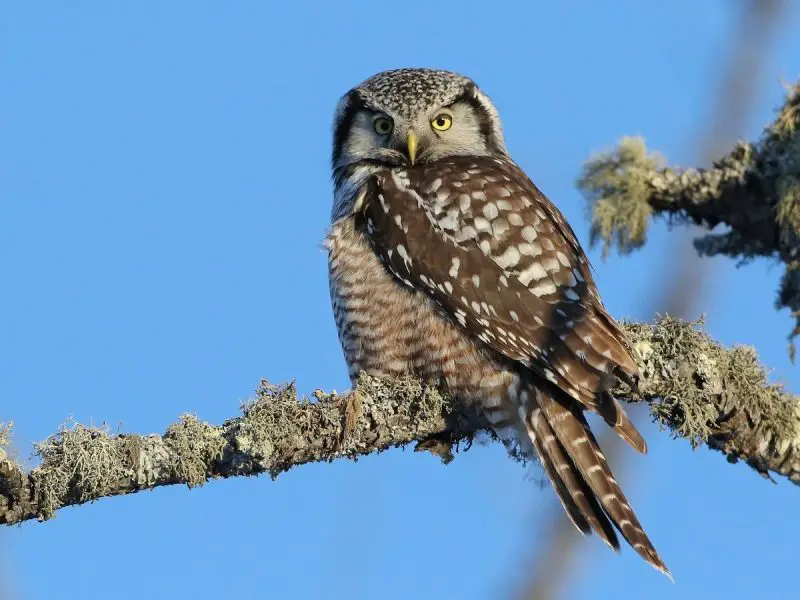
The Northern Hawk Owl is a unique and striking raptor, easily identified by its long, narrow tail, flat facial disk, and slender body that resembles a small hawk. Unlike most owls, it is diurnal, actively hunting during daylight hours. Adults typically measure about 14 to 18 inches in length, with a wingspan around 2.5 to 3 feet, and weigh around 10 to 14 ounces. Its plumage is brown with white spots, and the underparts are whitish with horizontal brown barring. It has vivid yellow eyes and a thin black border around its face.
This owl specializes in hunting in open boreal and subalpine habitats. It perches high on treetops or utility poles, scanning vast areas for movement. Its diet consists mainly of small mammals such as voles and mice, though it will also take small birds. Once it detects prey, it flies in a rapid, hawk-like dive to capture it. Northern Hawk Owls are known for their incredible vision, reportedly capable of spotting prey from up to a half-mile away.
In Wyoming, the Northern Hawk Owl is an accidental visitor, appearing only occasionally during irruptive years or unusual weather patterns. When they do arrive, they are most likely to be seen in the northern parts of the state or in open coniferous forests and meadows that resemble their native boreal habitat. Though rare, their diurnal behavior and hawk-like appearance make them a memorable and unmistakable sighting for lucky observers.
Northern Pygmy-Owl (Glaucidium gnoma)
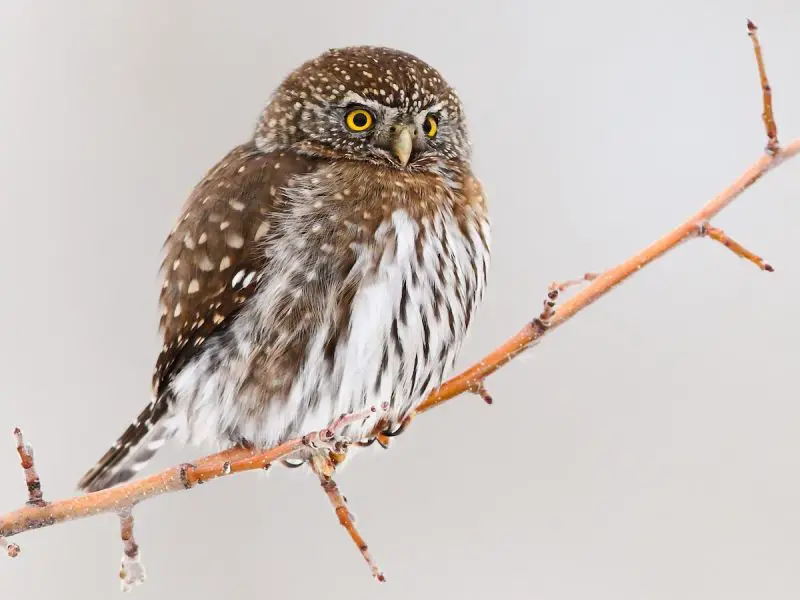
The Northern Pygmy-Owl is one of the smallest owl species found in Wyoming, measuring only about 6 to 7 inches in length with a wingspan of 12 to 16 inches. Despite its tiny size, this owl has a bold and fierce demeanor. It has a round head without ear tufts, bright yellow eyes, and a long tail. Its plumage is a mix of brown and white, often with faint barring on the chest and two black eye-like spots on the back of its head, which may help deter predators.
Unlike most owls, the Northern Pygmy-Owl is diurnal, meaning it hunts during the day. It mimics the behavior of hawks in flight, darting quickly through forests and surprising small birds, mammals, and insects. These owls are often seen perched motionless at the tops of conifers, scanning their surroundings for prey. Their call is a repeated series of high-pitched toots that echo through mountain woodlands.
In Wyoming, the Northern Pygmy-Owl is considered a rare forest dweller, with sightings typically reported in coniferous forests at higher elevations, especially in the northwestern mountains. Although secretive, their daytime activity and bold nature make them occasionally visible to alert birders, particularly in areas near Yellowstone and the Bridger-Teton National Forest.
Burrowing Owl (Athene cunicularia)
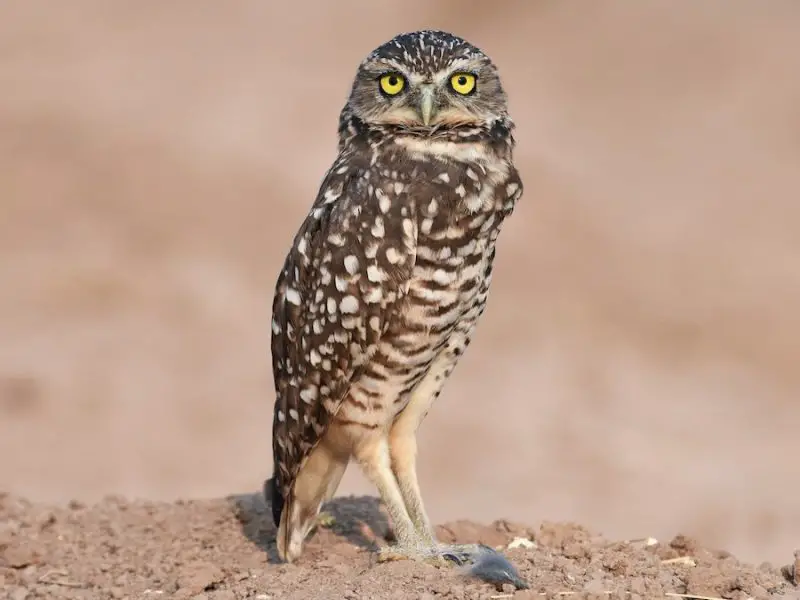
The Burrowing Owl is a small, ground-dwelling owl that stands about 7.5 to 10 inches tall, with long legs, a rounded head, and bright yellow eyes. It has light brown plumage speckled with white spots, giving it excellent camouflage among prairie grasses. Unlike tree-dwelling owls, this species is most often seen on the ground or perched on low mounds and fence posts, where it keeps watch for predators and prey.
This owl is unique among North American species for its underground nesting habits, often taking over abandoned burrows made by prairie dogs or ground squirrels. It is mostly active at dawn and dusk but can also be seen during the day. Burrowing Owls feed on insects, small rodents, and occasionally small birds. Their calls include a variety of chattering, cooing, and barking sounds.
In Wyoming, Burrowing Owls are considered local breeders, primarily found in open grasslands, sagebrush plains, and prairie habitats in the eastern and central parts of the state. Their numbers have declined in recent decades due to habitat loss, agricultural development, and declines in burrowing mammal populations. Conservation efforts are in place to protect remaining colonies and restore prairie ecosystems to support their breeding.
Flammulated Owl (Psiloscops flammeolus)
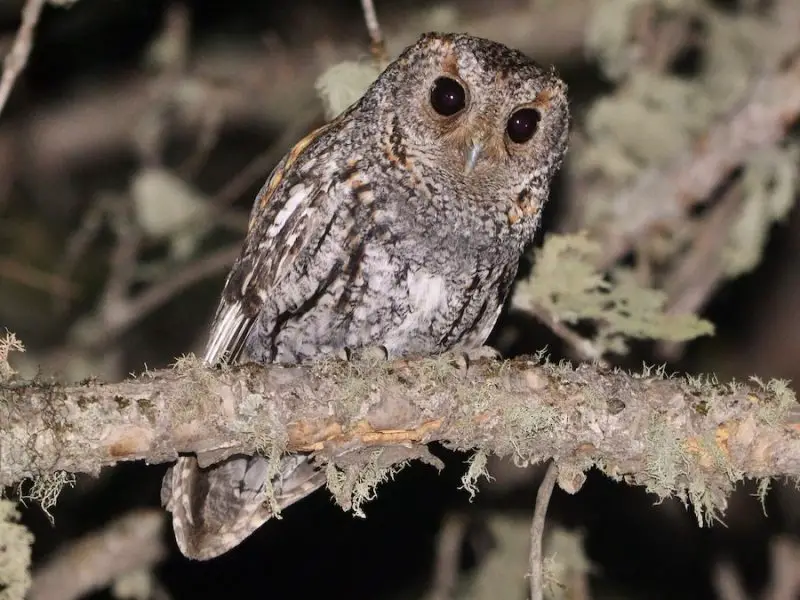
The Flammulated Owl is a tiny, migratory species measuring only 6 to 7 inches in length and weighing about 1.5 to 2 ounces. It has a mottled appearance with a mix of gray, brown, and rust colors that blend well into pine and fir trees. Its dark eyes, small size, and indistinct facial disk make it challenging to detect. This owl gets its name from the flame-like markings on its face and neck, which are especially visible at close range.
This species is entirely nocturnal and feeds mainly on insects such as moths, crickets, and beetles, which it catches in midair or picks off tree trunks. Its soft, low-pitched hoot sounds more like a distant toad than a typical owl, making it difficult to locate by ear. Flammulated Owls migrate to Central America for the winter and return to North America each spring to breed.
In Wyoming, confirmed breeding has been documented in the Jackson Hole area, where suitable mixed-conifer forests provide nesting and foraging habitat. Though rarely seen due to its secretive nature and nocturnal habits, it may be heard on calm spring or summer nights in dense forested areas. Its presence in the state is considered uncommon, and its reliance on mature forests makes it vulnerable to habitat changes.
Eastern Screech-Owl (Megascops asio)
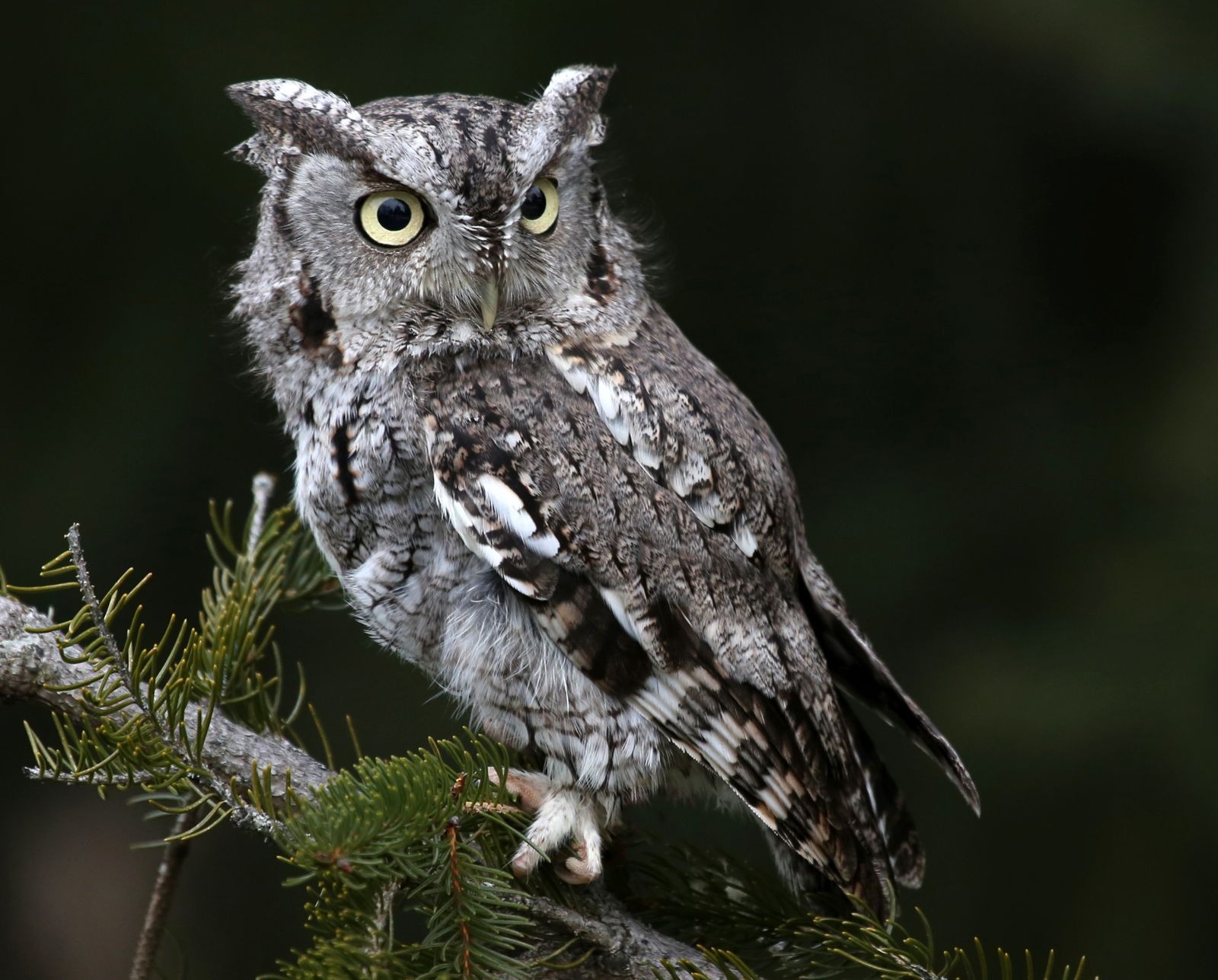
The Eastern Screech-Owl is a small, tree-dwelling owl measuring about 6 to 10 inches in length with a wingspan of 18 to 24 inches. It has short ear tufts, yellow eyes, and comes in two color morphs—gray and reddish-brown—which help it blend into tree bark. This owl has a distinct trilling or whinnying call, often heard on warm summer evenings.
A versatile and adaptable predator, the Eastern Screech-Owl preys on insects, rodents, small birds, and even amphibians. It is most active at night but can be seen roosting in tree cavities during the day. These owls often nest in natural holes or old woodpecker cavities and readily use nest boxes in suburban or rural woodlands.
In Wyoming, the Eastern Screech-Owl has a scattered distribution and is generally considered uncommon. It is most likely to be found in wooded river corridors, deciduous forests, or mixed woodlands in the eastern part of the state. Its quiet nature and excellent camouflage make it difficult to observe, but its calls can be a clue to its presence, especially during the breeding season.
Western Screech-Owl (Megascops kennicottii)
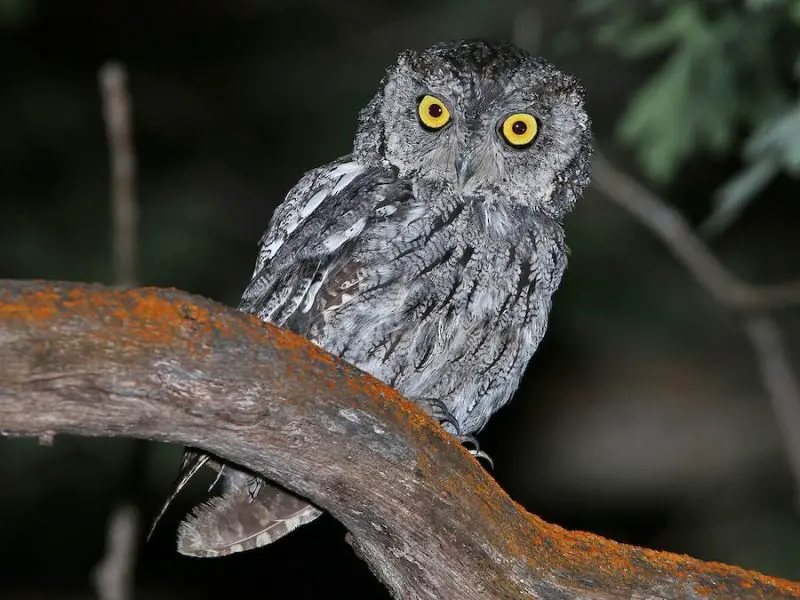
The Western Screech-Owl is a small but widespread owl in western North America, including much of Wyoming. It typically measures 7.5 to 10 inches in length with a wingspan of about 20 to 24 inches. It has short, pointed ear tufts, bright yellow eyes, and a gray to brown mottled appearance that helps it blend into tree bark. Its trilling or bouncing ball-like call is distinctive and commonly heard at dusk.
This owl is primarily nocturnal and feeds on a diverse range of prey, including insects, rodents, small birds, and occasionally fish or amphibians. It hunts from a perch, swooping down on prey with precision. Western Screech-Owls nest in natural tree cavities, old woodpecker holes, or nest boxes placed in suitable woodland habitats.
In Wyoming, the Western Screech-Owl is more commonly encountered than its eastern counterpart, particularly in the western and southern parts of the state. It favors riparian woodlands, mixed forests, and even residential areas with large trees. Most active at night and just after sunset, this owl is a frequent backyard visitor where nest boxes or large trees are available.
Long-eared Owl (Asio otus)

The Long-eared Owl is a medium-sized owl characterized by its distinct long ear tufts, slender body, and mottled brown and buff plumage that provides excellent camouflage among trees. It typically measures about 13 to 16 inches in length, with a wingspan of approximately 35 to 39 inches. Its facial disk is rounded and somewhat narrow, with orange to yellowish eyes that stand out against the darker feathers. Known for its secretive and skulking behavior, this owl tends to stay hidden in dense woodlands during the day.
Primarily nocturnal, the Long-eared Owl hunts by gliding silently through forest edges and open woodlands, feeding mostly on small mammals like voles, mice, and shrews, though it will occasionally take small birds. Its call is a distinctive, low-pitched series of hoots or grunts, often heard during the breeding season. This species nests mainly in abandoned stick nests of other large birds such as hawks or crows, usually well hidden in dense vegetation.
In Wyoming, the Long-eared Owl can be both a winter visitor and a local breeder, depending on food availability and climate conditions. It is mostly found in wooded areas with dense cover across the state’s foothills and mountain forests. Sightings are more frequent during the winter months when they move into lower elevations, and their elusive nature makes them challenging to spot.
Short-eared Owl (Asio flammeus)
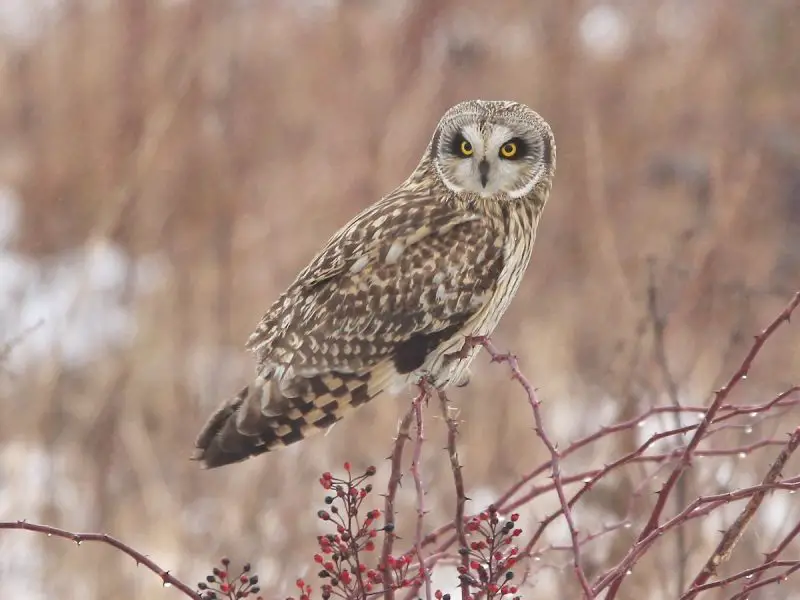
The Short-eared Owl is a medium-sized, open-country owl easily recognized by its relatively short ear tufts, round facial disk, and mottled buff and brown plumage. It measures about 13 to 17 inches in length, with a wingspan ranging from 33 to 43 inches. Its pale face and bright yellow eyes make it distinct among grassland raptors. Unlike many owls, Short-eared Owls are often active during the day, especially at dawn and dusk.
This species is primarily a ground-nester, often choosing open grasslands, marshes, and prairies for breeding. Their diet consists mainly of small mammals such as voles, mice, and shrews, which they hunt by flying low over open fields in slow, buoyant flights. Their calls include a series of hoots, barks, and hisses used for communication during the breeding season.
In Wyoming, the Short-eared Owl is a migratory and uncommon species, usually found in the state’s open grasslands and shrub-steppe habitats during migration or winter. Because of habitat loss and other environmental pressures, it is considered vulnerable in Wyoming. Conservation efforts focus on protecting grassland habitats to support this elusive owl’s breeding and wintering needs.
Boreal Owl (Aegolius funereus)

The Boreal Owl is a small, forest-dwelling owl with a round head, large yellow eyes, and no ear tufts. Measuring about 9 to 11 inches in length with a wingspan of approximately 20 to 24 inches, it has a compact body covered in soft, mottled gray and brown feathers. Its facial disk is bordered with white and black, giving it a distinct appearance in dim forest light.
Nocturnal and elusive, Boreal Owls primarily hunt small mammals such as voles and mice, which they detect through acute hearing and vision in dense coniferous forests. Their call is a high-pitched series of whistles and trills, often heard on calm nights. These owls nest in tree cavities or use abandoned woodpecker holes, favoring mature spruce and fir forests.
In Wyoming, Boreal Owls inhabit higher-elevation coniferous zones, particularly in the northern and western mountainous regions. They are considered year-round residents but can be difficult to observe due to their secretive habits and preference for dense forest cover. Their presence indicates healthy, mature forest ecosystems.
Northern Saw-whet Owl (Aegolius acadicus)

The Northern Saw-whet Owl is one of the smallest owls in Wyoming, measuring about 7 to 8 inches in length with a wingspan of roughly 16 to 20 inches. It has a round head without ear tufts, large yellow eyes, and brown-and-white streaked plumage that provides camouflage in woodland environments. Its name comes from its call, which sounds like a saw being sharpened, consisting of a repeated, high-pitched whistle.
This owl is primarily nocturnal but can sometimes be active during the day. It feeds mainly on small rodents like mice and voles, which it hunts by quietly flying low through dense forests. Northern Saw-whet Owls readily use nest boxes when natural cavities are unavailable, making them popular subjects for conservation and study.
In Wyoming, the Northern Saw-whet Owl is a migratory woodland species found in mixed and coniferous forests across the state, especially at mid to higher elevations. Their small size and secretive nature make them difficult to spot, but their distinctive calls are often heard during the breeding season. Their reliance on forested habitats makes them sensitive to changes in woodland ecosystems.

